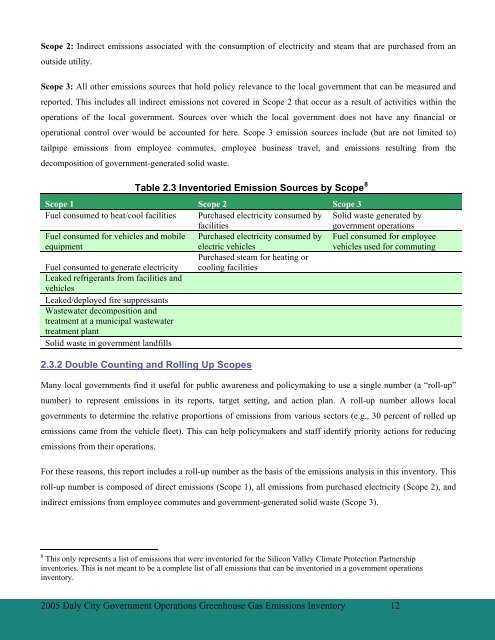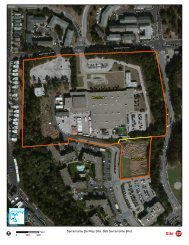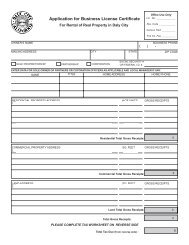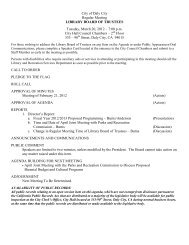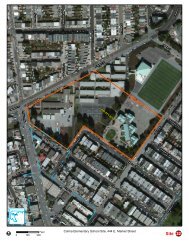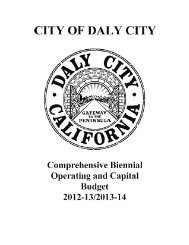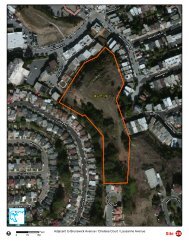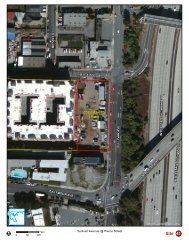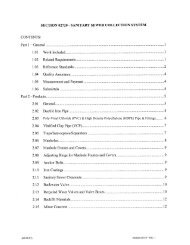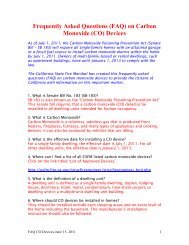Daly City's Green Vision - City of Daly City
Daly City's Green Vision - City of Daly City
Daly City's Green Vision - City of Daly City
Create successful ePaper yourself
Turn your PDF publications into a flip-book with our unique Google optimized e-Paper software.
Scope 2: Indirect emissions associated with the consumption <strong>of</strong> electricity and steam that are purchased from an<br />
outside utility.<br />
Scope 3: All other emissions sources that hold policy relevance to the local government that can be measured and<br />
reported. This includes all indirect emissions not covered in Scope 2 that occur as a result <strong>of</strong> activities within the<br />
operations <strong>of</strong> the local government. Sources over which the local government does not have any financial or<br />
operational control over would be accounted for here. Scope 3 emission sources include (but are not limited to)<br />
tailpipe emissions from employee commutes, employee business travel, and emissions resulting from the<br />
decomposition <strong>of</strong> government-generated solid waste.<br />
Table 2.3 Inventoried Emission Sources by Scope 8<br />
Scope 1 Scope 2 Scope 3<br />
Fuel consumed to heat/cool facilities Purchased electricity consumed by<br />
facilities<br />
Solid waste generated by<br />
government operations<br />
Fuel consumed for vehicles and mobile<br />
equipment<br />
Purchased electricity consumed by<br />
electric vehicles<br />
Fuel consumed for employee<br />
vehicles used for commuting<br />
Fuel consumed to generate electricity<br />
Purchased steam for heating or<br />
cooling facilities<br />
Leaked refrigerants from facilities and<br />
vehicles<br />
Leaked/deployed fire suppressants<br />
Wastewater decomposition and<br />
treatment at a municipal wastewater<br />
treatment plant<br />
Solid waste in government landfills<br />
2.3.2 Double Counting and Rolling Up Scopes<br />
Many local governments find it useful for public awareness and policymaking to use a single number (a “roll-up”<br />
number) to represent emissions in its reports, target setting, and action plan. A roll-up number allows local<br />
governments to determine the relative proportions <strong>of</strong> emissions from various sectors (e.g., 30 percent <strong>of</strong> rolled up<br />
emissions came from the vehicle fleet). This can help policymakers and staff identify priority actions for reducing<br />
emissions from their operations.<br />
For these reasons, this report includes a roll-up number as the basis <strong>of</strong> the emissions analysis in this inventory. This<br />
roll-up number is composed <strong>of</strong> direct emissions (Scope 1), all emissions from purchased electricity (Scope 2), and<br />
indirect emissions from employee commutes and government-generated solid waste (Scope 3).<br />
8 This only represents a list <strong>of</strong> emissions that were inventoried for the Silicon Valley Climate Protection Partnership<br />
inventories. This is not meant to be a complete list <strong>of</strong> all emissions that can be inventoried in a government operations<br />
inventory.<br />
2005 <strong>Daly</strong> <strong>City</strong> Government Operations <strong>Green</strong>house Gas Emissions Inventory 12


